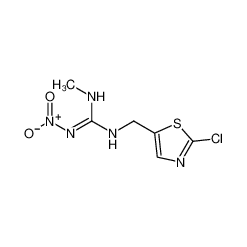
CAS No.: 210880-92-5 Formula: C6H8ClN5O2S
Weight: 249.67800
Synonyms: TI 435; Apacz; Pancho; 3-(2-chloro-5-thiazolylmethyl)-1-methyl-2-nitroguanidine; Poncho
Clothianidin is an insecticide developed by Takeda Chemical Industries and Bayer AG. Similar to thiamethoxam and imidacloprid, it is a neonicotinoid. Neonicotinoids are a class of insecticides that are chemically similar to nicotine, which has been used as a pesticide since the late 1700s. Clothianidin and other neonicotinoids act on the central nervous system of insects as an agonist of acetylcholine, the neurotransmitter that stimulates nAChR, targeting the same receptor site (AChR) and activating post-synaptic acetylcholine receptors but not inhibiting AChE. Clothianidin and other neonicotinoids were developed to last longer than nicotine, which is more toxic and which breaks down too quickly in the environment. However, studies published in 2012 show that neonicotinoid dust released at planting time may persist in nearby fields for several years and be taken up into non-target plants, which are then foraged by bees and other insects.; Clothianidin is an alternative to organophosphate, carbamate, and pyrethroid pesticides. It poses lower risks to mammals, including humans, when compared to organophosphates and carbamates. It has helped prevent insect pests build up resistance to organophosphate and pyrethroid pesticides. According to the Environmental Protection Agency (EPA), clothianidin's major risk concern is to nontarget insects (honey bees). Information from standard tests and field studies, as well as incident reports involving other neonicotinoid insecticides (e.g., imidacloprid) suggest the potential for long term toxic risk to honey bees and other beneficial insects. In January 2013, the European Food Safety Authority stated that neonicotinoids including clothianidin pose an unacceptably high risk to bees, concluding, "A high acute risk to honey bees was identified from exposure via dust drift for the seed treatment uses in maize, oilseed rape and cereals. A high acute risk was also identified from exposure via residues in nectar and/or pollen."